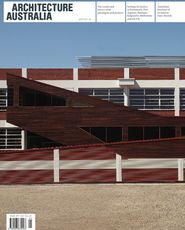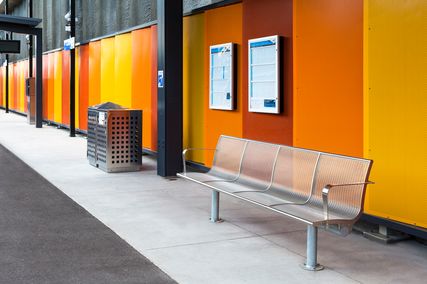The Architecture of the Australian Courthouse
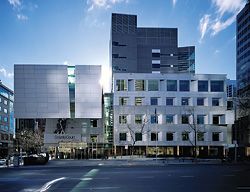
Elevational view of the Victorian County Court by Daryl Jackson Architects, Lyons and SKM Architects, architects in association (2002).
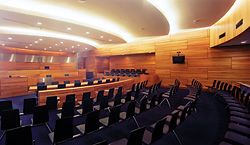
The Ceremonial Court at the Victorian County Court. Photography Trevor Mein.
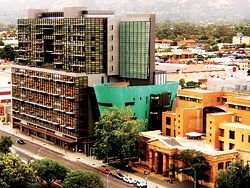
The changing face of justice in Victoria Square, Adelaide. The Adelaide Commonwealth Law Courts by Hassell, 2008 (left of image), sits adjacent to the Adelaide Magistrates Court, formerly the Supreme Court of South Australia, 1851, by Colonial Engineer Edward Frome or his successor Richard Lambeth. Photograph Helen Sewell.
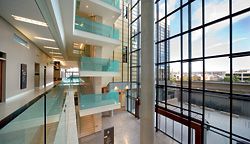
The open atrium at the Adelaide Commonwealth Law Courts. Photograph John Gollings.
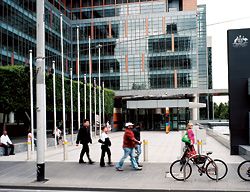
The forecourt of the Melbourne Commonwealth Court Building (1999) by Hassell. Photograph Max Creasy.
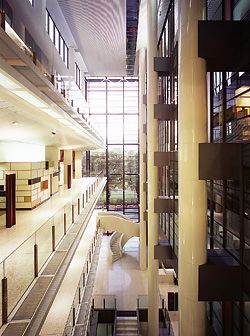
The atrium of the Melbourne Commonwealth Court Building. Photograph Trevor Mein.
Towards therapeutic and restorative justice – Graham Brawn outlines the substantial shifts in thinking about justice and court design of the last two decades.
Justice, the administration of justice and concepts of an ideal courthouse have recently undergone a period of review, change and paradigm shifts, similar to that seen in the corporate workplace and in learning and healing places. The role of the courts, the scope and relevance of justice services, the structure and operation of court administration and the importance of appropriate architectures have received, and still receive, critical strategic attention, which began in the mid to late 1980s.
Unlike private and social institutions, the concepts and practices of justice are the result of a form of contract between the courts and the state, territorial and federal governments. In general, this leads to a creative tension about what is good court architecture and how it might be achieved. While the governments appoint the judicial officers – the justices, judges and magistrates – and provide the courts with their accommodation and administration, the courts are independent of any directions from the state when they apply and interpret the laws set by those governments.
Restructuring the justice system
Through all the change of the last two decades, there remains an unwavering commitment to upholding the authority of the law while making the work of the courts and tribunals relevant, respected, transparent, accessible and affordable. The pursuit of these principles has resulted in considerable restructuring and shifts in the paradigms of a good justice system.
We have seen the growth of administrative tribunals as a means of making the pursuit of civil disputes more accessible and affordable for the general community. The result is a new judicial building type – the tribunal and mediation complex, where individuals can pursue resolution of disputes without legal representation in an atmosphere where, we hope, help and guidance from staff is balanced with a sense of the significance of the occasion.
At the Commonwealth level, the various courts have grown in their presence with the construction of new facilities in Perth, Brisbane, Melbourne and Adelaide. The Federal Court (1975), the Family Court (1975) and the Federal Magistrates Court (1999) are relatively young in the overall scheme of things, and with the High Court required to circuit to all states and territories, there was a compelling need for new premises, particularly since much corporate law work seems to be conducted within the Federal Court.
At the state level the magistrates’ courts are drawing on the concepts and principles of therapeutic justice and restorative justice to become a vehicle for addressing the causes behind criminal cases, rather than the symptoms or the offense before the court. In various forms there are now Drug Courts, Family Violence Courts, Circle Courts and, in Victoria, the Collingwood Neighbourhood Justice Centre. Many of these courts suspend a sentence for offenders prepared to plead guilty and willing to enter and succeed in programs that will address the underlying causes of their offending – acquiring job skills, reduced drug and alcohol dependency, or anger management. These courts are deliberately socially interventionist and require quick access to skilled staff for assessments of the offenders’ situations and possible success in a program. This is reshaping the role of magistrates’ courthouse from one of trials and hearings to a place that citizens can turn to for support in dealing with the complexities of contemporary life. The Collingwood Neighbourhood Justice Centre, which reflects models developed in North Liverpool, United Kingdom, and Brooklyn, New York, was established as a pilot program that seeks to restore respect for justice in a community in which many non-European migrants have settled and for whom our concept of justice and law and order are quite alien.
Social and cultural sensibilities
The last few decades have seen considerable attention to the overly high representation of Indigenous people in our courts and prisons and the creation of Aboriginal courts – Koori, Murri and the New South Wales circle sentencing program in Eastern Australia, Nunga Courts in South Australia and Community Courts in Western Australia use collaborative processes in deciding on sentencing options. To overcome mistrust of the criminal justice system, Elders participate in the process, as advisors to the magistrate, and add significance to the occasion through the tradition of respect for them and the impact of being shamed before them. This concern to make justice relevant to all users has been extended to take into account: a need for actual and perceptual access to the outdoors and fresh air, how and where people wait for others and for their appearance in a trial or hearing, and a need to be separate from some others in the family or tribe. All of this has informed the design of the courthouses at Port Augusta and Kalgoorlie, and has changed the parti from the internal, low-external-wall-perimeter-to-gross-floor-area, squarish-floor-plan models of the recent past to the narrow, open-to-outdoors models, often single-loaded corridor models, of many of the current exemplars.
A concern for the trauma for victims in rape and sexual abuse cases in reliving the event, and having contact with the perpetrators and/or their supporters, has led to design briefs calling for a combination of separate circulation for the victims to and from the courtrooms or remote witness rooms, and plenty of separation in the waiting areas. The separation of the waiting areas as well as the seating areas in the public galleries of a courtroom also addresses the needs of feuding families or groups who may be involved in the same matter. More recently, there has been a growing awareness of the different ways in which ethnic groups use space.
Towards a virtual world
Technology continues to have an enormous impact on the operation of cases in courtrooms and the administration of justice. We are now close to having witnesses “appear” in a trial as a holograph, while all states have forms of audiovisual links to connect remote witnesses and accused persons to a trial or hearing, and in some cases conduct a trial with a judge in one location and other participants in another or other locations (part of the brief for the new Kalgoorlie Court). These communication networks allow vulnerable witnesses to participate in a trial without the trauma of contact with the accused, reduce the transportation costs and security risks of moving accused persons to and from courts for technical appearances, bring justice to the remote communities in our outback, and offer a potentially more effective use of scarce resources of skilled judicial officers, legal counsel and expert witnesses. To enhance the administration of justice, most states are now able to accept, electronically, all the applications and documents that need to be submitted to start a matter and during the trial or hearing. Where states have changed their legislation, this means that the electronic files are the “file of record”, thereby reducing the considerable amounts of space consumed by paper files that are held for years and years.
In a recent large civil corporate case in the NSW Supreme Court, a whole suite of facilities had to be created to accommodate the case, which lasted around ten months and involved some thirty lawyers representing the various parties. In addition to work space for each legal team, there was a complete IT fitout to connect all the participants, AV screens for the press and the public and access to and use of the electronic files. Each of the thirty lawyers had three screens at their seat at the bar table, one for the concurrent transcript, another for the electronic evidence that was being referred to, and the third for their own computer files and records.
In addition, there are IT cafes to give the public access to information within the courthouses, especially in the registry offices; extensive use of video cameras in safety and security systems; airport-lounge-type business centres for lawyers to maintain contact with their offices; and the same for jurors to maintain contact with personal and work lives when not in a trial. In many jurisdictions, court recording is now done from outside the courtroom, even off-site, through digital recordings.
Changing expectations of justice environments
In addition to all the organizations, such as the Australasian Institute of Courts Administration, and individuals who have advocated change in the justice system, the application of the law, the administration of justice and law reform, four factors have influenced the shape, form, structure and expression of courthouse architecture. These are: a series of cross-disciplinary and mixed user and designer conferences; the impact of the almost revolutionary shift in the organizational, spatial and material aspects of the architecture of the Victorian County Court, by Daryl Jackson Architects, Lyons and SKM Architects, architects in association (2002); the vision and dedication of Chief Justice Black of the Federal Court of Australia as the Commonwealth built three new Commonwealth court buildings in Brisbane (1993), Melbourne (1999) and Adelaide (2008); and the acknowledgment by the Victorian Attorney-General of the important role that buildings and their designs play in effecting change and its manifestation in a number of interesting projects.
From the mid-1990s, there have been frequent opportunities for architects to meet with court administrators and judicial officers to discuss the challenges of court architecture in a changing society and ways of anticipating changes in law, court practices and justice services. The 1998 conference Representing Justice, organized by The Centre for Court Policy and Administration, University of Wollongong, and the subsequent Court of the Future Network’s conferences on court architecture, security and technology, its four jury research and practice conferences, and its two executive tours to Europe on court architecture have been forums for the most senior justices, jurists, architects, engineers, psychologists, judicial officers, lawyers, criminologists and academics to address the architecture and the lived experiences of justice environments.1 This exchange of views has melded the thinking of users and designers into shared understandings of expectations and possibilities for the next generation of courthouses. From these forums have come a number of themes that are now almost accepted orthodoxy for Australian courthouse design, which revolve around user satisfaction and the lessons from environmental psychology.
Courthouses that feel airy, are full of natural light and have good wayfinding, access to the outdoors and meaningful views out of interior spaces such as courtrooms and jury deliberation rooms are now more the norm than the exception they were only a few years ago. Functionally, at least four and in some cases five separate circulation systems are now expected – ensuring that juries, judges, persons in custody, the public and, in some cases, administrative staff or vulnerable witnesses do not meet while in the building. Safety and security is a continuing challenge to design and design thinking – all participants want to feel safe, but nobody wants the courthouse to feel like a fortified camp. Most weapons are detected at the security screening at the entrances; however, intimidation and angry outbursts are more likely outside the courtrooms and hearing rooms. The response to these daily realties has been to rethink the corridors, approaching them as placemaking in the public realm – outdoor access, views, natural ventilation, places near courtrooms where groups can separate themselves, and even separate entrances into “bride” and “groom” sides of the public galleries in courtrooms. Open public spaces that facilitate ready oversighting are now married to the ability to zone off areas to manage high-risk, high-profile trails without interrupting the normal operations of other courtrooms. Many of these qualities are evident in the projects that follow.
The Victorian County Court, a BOO scheme owned and maintained by The Liberty Group, was provided through the PPP process. The high level of function, design, cost and timeliness has set a standard that other jurisdictions seek to emulate, although through different procurement methods. It has shown that good urban and building design can be achieved on affordable budgets, with generous architectural qualities and spacious public realms. In short, it raised expectations considerably in many Australian and New Zealand jurisdictions.
The Commonwealth Courts construction program championed by the Chief Justice of the Federal Court, Justice Michael Black, AC, has led to a rethinking of symbolism, presence and contemporary forms of public architecture. With the High Court in Canberra as a model, these buildings reintroduce the power of architectural space to the designers’ palette, a quality lost during the dominance of the utilitarian and then commercial paradigms of the 1970s through to the 1990s. They also respond to challenges of making justice feel accessible, and not losing the significance of the occasion through poor architectural planning and design. Further, the Melbourne and Adelaide projects, both by Hassell, capture the importance of designing the setting of civic buildings, through a sense of approach and arrival, be it outside in Melbourne or inside as in Adelaide. The business of justice is on display in Commonwealth courts, as it is in the Victorian County Court, Parramatta, Port Augusta and Collingwood, and will be in Brisbane and Kalgoorlie.
Under the leadership of Attorney-General and Deputy Premier the Honourable Robert Hulls, Victoria has been in a state of change and experimentation. While the VCC began under a previous government, the approval to enter into the BOO contract came within weeks of the change of government. The formal introduction of the Koori Court at Shepparton, with Dr Kate Auty as magistrate, and then the Collingwood Neighbourhood Justice Centre have led to Koori settings in most adult and juvenile courthouses, and to the move to a more interventionist or therapeutic role for the Magistrates’ Court. The Attorney-General has acknowledged that new, well-designed buildings are needed to fully introduce the reforms he has initiated. This has made for a new culture of design, where the design process is a partner in effecting change, not just a reaction to change.
Civic roles of courthouses
Ideas of safe and just societies have been, and continue to be, forces for shaping and reshaping new and old Western societies. The courthouse has been an icon of the commitment to justice, a symbol of law and order, and a shaper of the built form of many communities. Our older courthouses are usually the focus of a legal precinct, especially in the capital cities, while one senses that in places where new court buildings have been drawn to the fringe or open edges of communities, the civic focus of the community has suffered. In Adelaide the new Commonwealth courts add gravitas to the presence of the Magistrate, District and Supreme Courts of South Australia around Victoria Square. The Parramatta Trial Courts and the new adjacent Children’s Court join Commonwealth and state court buildings to reinforce the justice focus of that city. In Brisbane and Sydney current, new and reformation courts projects reinforce the respective civic roles of George and Macquarie Streets.
Internally, the layout and operation of the courtrooms are often an expression of the nationalities of the early legal profession and judiciary. In Victoria the jury courtroom is laid out in the Irish manner, whereby the instructing solicitors sit with their backs to the judge, while in most other states they sit behind the barristers. In all states there are very special conditions on where the witnesses and accused should be located. In South Australia the witness box is often beside the prisoner dock, as an expression of the need for the accused to “be tried in the presence of their accusers”. While in some states the prisoner dock has to be opposite the jury box, in Queensland it is in the middle of the courtroom, opposite the judge and beside or in front of the public. These colonial-based differences have been reinforced by Commonwealth courts, which have followed the state traditions of courtroom layout in their new buildings.
In heritage structures the need to respond to changing justice models and processes, and to benefit from technology, has been a challenge. In many cases, this has been met by ingenious architectural tactics, so one still feels the architectural essence and tactics of the original designs, especially the Francis Greenway Courthouse in Sydney and the Supreme Court in Melbourne, where there have been considerable adaptations and upgrades in their functional and technical performance.
Justice architecture as place making
Finally, there is now an expectation that courthouses are people places. In addition to the call on justice architecture to help maintain a respect for the law, the growth in the number of problem solving courts in all states, together with commitment of varying degrees to the philosophies of therapeutic and restorative justice, has changed the desired image of courthouses, especially at the magistrate level. There is now an expectation that the public’s view of the new courthouse is as much of a place to which one goes for help as a place to receive a judgment on an offence or a dispute. This change, along with the creation of Indigenous courts and a desire to respect social and cultural differences among participants in matters before the courts, marks a significant paradigm shift, which challenges designers to create new models of architectural place making within the continuing traditions of justice architecture.
Graham Brawn is Professor Emeritus in Architecture at the University of Melbourne.
1. The Court of the Future Network describes itself as a group of architects, engineers, psychologists, judicial officers, lawyers, criminologists and others in Australia and New Zealand who work closely with court communities to improve the quality of justice environments. See www.courtjustice environments.edu.au

